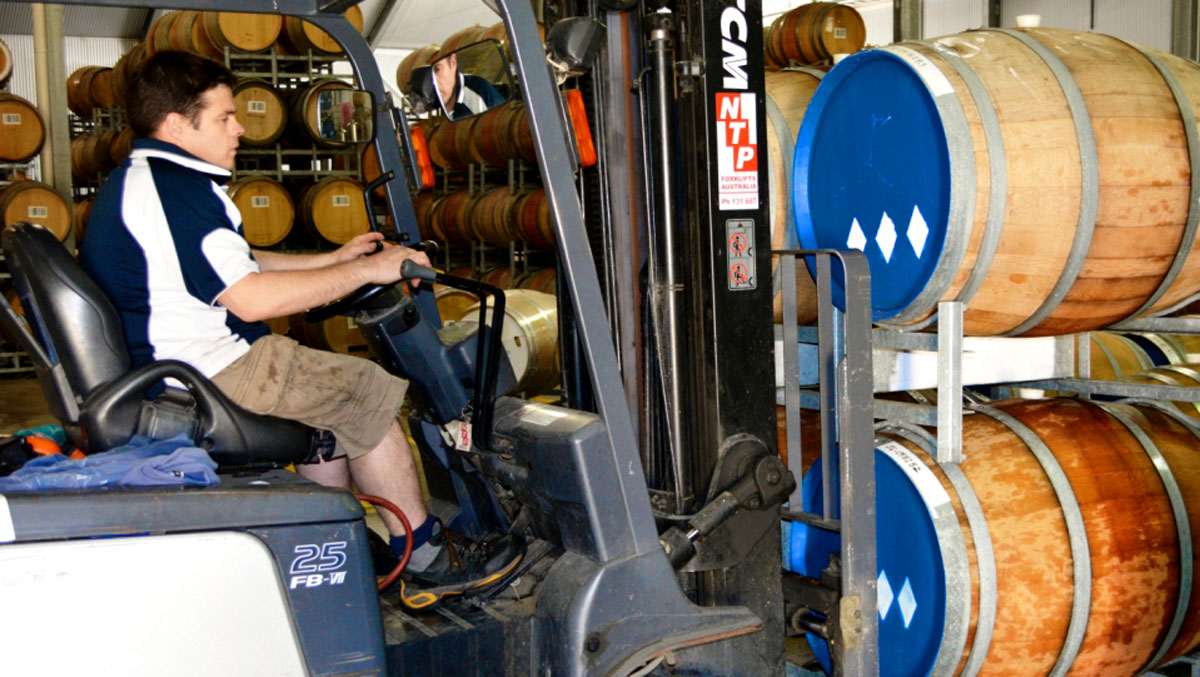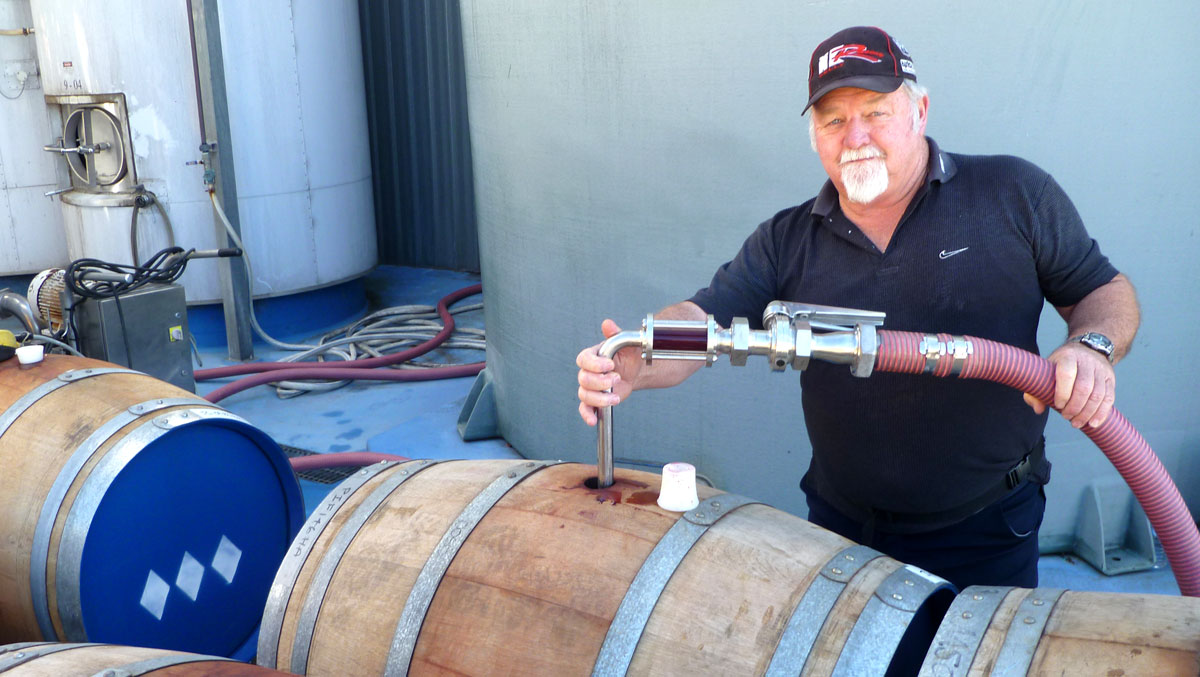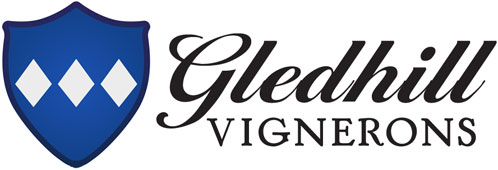About
Meet John and Brendon Gledhill
A winery that stems from the roots of the Gledhill name
Originating from Northern England with poll tax records dating back to at least 1275AD, the Gledhill name has been traced back to a family who lived around the Gledhill region in the west riding of Yorkshire. The name is thought to have originated from the old English word for ‘kite’ called Glede or Gleoda and ‘hyll’ meaning hill.
Read the label
Our wine label is a slight variation of the traditional Gledhill family crest and coat of arms.
The original Gledhill coat of arms and family crest was a shield of Azure with three fesse argent (silver) lozenges or diamonds. The coat of arms also featured a half rampant lion in some depictions and in others a rooster or cockerel, or a red kite resembling a small eagle may be observed.
You will notice on our label, the lozenges are white as this contrasted better on the bottle with the blue colour we developed to best match the original azure, while still maintaining consistency with the colour of the chosen closure for the bottle, and there is a half rampant tiger with a gold crown depicted in place of the lion in the top centre of the crest to symbolise John’s lifelong fascination with the largest and most powerful of world’s ‘big cats’, the Tiger.
Gledhills in Australia
The Gledhill family name has been traced back a total of seven generations in Australia, with the first Gledhill’s arriving in Australia as free settlers in the mid 1800’s, eventually establishing a home near Bendigo in Victoria as Miners and lumberjacks before moving further inland and along the Murray River becoming farmers to our current location in Coomealla in Sunraysia, the source of the grapes that make the wine that you are now able to drink today.

John Gledhill
Winemaker
Following his school years, John spent time studying and working on the vineyards before being accepted into a new degree in Viticulture at LaTrobe University. The first year was offered in Mildura meaning John could continue to work on the vineyard after lectures and weekends, allowing him to not only put the theoretical knowledge into practice, but also develop a theoretical understanding of the practical applications he had learned from his forebears.
This degree led John to a work experience stint at Mitchelton Wines in Nagambie, central Victoria, a three-week period in mid 2001 that would inspire a passion for wine and interest in winemaking shaping the career path in a new and exciting direction.
The work experience opportunity then led to a cellarhand position for the 2002 vintage, followed by a fulltime position in the cellar after the vintage was completed, this did however mean that John’s degree in viticulture was left deferred just one assessment shy of graduation.
During the next few years, John developed an operational understanding of the winemaking process, with invaluable tuition from Mitchelton’s senior winemaker Don Lewis and winemaker Toby Barlow. Don, who also grew up in Sunraysia became a much respected mentor of John’s.
Don was a highly regarded member of the winemaking community producing some of the country’s best Rieslings and Rhone Valley wine styles.
During his time in the cellar, John developed a strong understanding of all operations and processes involved in producing both commercial and premium red and white wines. John’s childhood learning process was again followed, as he learned his craft in the cellar by watching, copying and questioning his Cellar Manager, Mark Clydesdale and senior cellar operators Simon Gribbin and Noel Welsh, all three of whom played an integral part of John’s development.
While working at Mitchelton, John’s quest for a theoretical understanding of what he was learning in the cellar led him to apply for enrolment in Charles Sturt University’s Wine Science degree. In 2005 his application was successful and he was admitted into the institution which offered a distance education enabling students to maintain full time employment while navigating study. At the same time, Mitchelton offered John an internship as a trainee winemaker, expanding his responsibilities to include oak barrel management and vintage nightshift supervision.
In June 2006, John moved interstate to South Australia to live with his now wife and company shareholder Lucy Richardson. After door knocking with his CV, he secured employment as Winemaker and Viticulturist for a family based wine company with vineyards in Clarendon, Finniss and the Riverland. It was here that John was able to implement what he had learned at Mitchelton and work under the leadership and direction of another respected mentor, world renowned winemaker, Chris Ringland, creating and crafting a range of red, white and sparkling wines that were predominantly sold throughout the USA, Canada, the UK and Asia.
It was this stage of John’s career that introduced him to the contract winemaking facility based on the outskirts of Langhorne Creek known as Belvidere Winery. Belvidere, through the generosity of Managing Director Mark Turnbull and the assistance of Paul Zeitz, Scott Quigley, the cellar staff and the lab team was to become a critical component in the production of Gledhill Vignerons first wine, the 2009 Gledhill Cabernet Sauvignon.
In late 2010, an opportunity arose for John to join the globally recognised brand, Rosemount Estate as a member of their winemaking team. Very much the junior winemaker, John’s learning curve in the corporate structure of Treasury Wine Estates was steep.
Guided by Matt Koch, Andrew Locke, Randall Cummins, Trevor Tucker and Priscilla Buckley, as well as very experienced cellar and lab teams, John slotted in seamlessly learning much and growing to love McLaren Vale as a region.
Over the next 4 years, the brand became the most highly awarded Australian brand in National and Regional wineshows across the country as well as the highly regarded International wine challenges. Rosemount won medals for over 80% of the wines they entered in these wine shows, including over 20% Gold medals, where the national average is 6% Gold.
Sadly, this golden era for Rosemount in McLaren Vale came to an abrupt halt in December 2014, when the brand owner made the decision to close the McLaren Vale winery, leaving all 33 full time staff redundant and looking for new jobs.
Fortunately for John, an internal opportunity to undertake the 2015 vintage at Penfolds in the Barossa Valley arose, so John jumped at the opportunity to be vintage/nightshift winemaker for one of the world’s most iconic wine brands. Early in the harvest, John frequented Penfolds vineyards and assisted in harvest grading and timing, before making the switch to managing nightshift winemaking responsibilities and built a strong rapport with not only the Penfolds winemaking team, but also worked very closely with the cellar and lab teams while there.
John’s love of fortified wines was further enhanced during this time as he was able to shadow the Penfolds fortified winemaking team of James Godfrey and Matt Woo, being involved in grading and classification tastings, operational decisions and protocols as well as final blending and bottling preparation of some of the grandest and oldest port wines Australia produces.
John then took up the position of Research Winemaker for WIC Winemaking Services in July 2015, which is a joint venture between the University of Adelaide and The Australian Wine Research Institute. Another steep learning curve ensued as John went from managing 50–100 tonne batches of fruit and wine, to 20–100kg parcels. He soon learned that there was just as much involved in small batch winemaking as commercial scale production, with one major point of difference, ‘there was nowhere to hide any mistakes’.
In this role, John has been at the forefront of viticultural and winegrape research, responsible for developing and implementing specific winemaking protocols to assist the research organisations maximise their outcomes and provide value back to industry.
John’s clients include both University of Adelaide and AWRI, as well as CSIRO, state Department of Agriculture bodies and some external commercial clients who have acknowledged the improvement in wine quality delivered and professionalism in the team he has built since John began in the role.

Brendon Gledhill
Grape Grower
Gledhill Vignerons is a FAMILY owned and operated wine company, that, although is only young in its current form of development, does stem from a very long and proud viticultural heritage that spans 5 generations within the Gledhill name, and 6 generations by via another Great-great-great grandfather, who’s property still exists as part of Best’s Concongella Vineyard near Great Western, in Victoria.
Currently the family owns a vineyard in Coomealla, on the NSW side of the Murray River near Mildura in Australia’s fruit bowl, the Sunraysia Horticultural region. The climate is Mediterranean with a long hot summer, mild winters and very desirable long daylight hours during the crucial ripening season from veraison in November, through to harvest, when the flavours are right in March.
The vineyard is owned and operated by, Director and Shareholders, Brendon and Jenny. Brendon has had a lifetime association in the viticulture industry, professionally and in the Research and Regulatory areas. As a viticultural industry advocate, Brendon was a member of the initial Dried Fruit Research Council for six years, driving and developing a successful Research model and then the Dried Fruits Research and Development Council, becoming Deputy Chair of that body, for a further six years. In that role, Brendon studied, oversaw and reviewed much of the viticultural research in Australia for the Wine, Table and Dried Fruits Industries.
He was also a long-serving member of the NSW Dried Fruits Board, which regulated the production, packing and selling of Dried Fruits. He also assisted the NSW Government to re-write the Dried Fruits Act and Regulations being selected as the grower representative to the parliamentary review.
Brendon developed his particular interest in research and innovation with his first employment in 1967, at the Commonwealth Scientific and Industrial Research Organisation (CSIRO), Horticultural Research Station at Merbein, near Mildura, where he worked on projects including “Wine Grape Yield Forecasting” and the “Introduction of Mechanical Grape Harvesters into Australia”. Being mentored by both Dr. Alan Antcliff and Dr. Peter May, this work was to shape Brendon’s keen interest and adoption of new technology in farming.
Brendon and his eldest son John, Gledhill Vignerons Managing Director, both learned their viticultural practices from Brendon’s parents, Norm and June Gledhill, who together had developed a vine property in Coomealla’s 3rd Allocation, Soldier Settlement area as a part of the War Service Land Settlement Scheme. This soon to be vineyard was forged from rugged Mallee and Belar scrub east if the town of Dareton in 1953. This was to be their family business and home until Norm’s passing in 1996. A second property, the current Gledhill Vineyards property and primary source of Gledhill Vigneron’s grapes, was purchased by the family for expansion in 1974.
Brendon and Jenny raised their family on this property, Jodi (dec), John, Nikki and Scott, and over the years has seen a shift from citrus and dried fruit production to a small patch of winegrapes grown with the intention of providing fruit for the Gledhill wines.
The region is not recognised for winegrape production, let alone Cabernet Sauvignon production, however, low yields, deficit irrigation strategies and attention to detail has seen the Gledhill Cabernet wines take on and outscore Cabernet Sauvignon wines of the same vintage originating from some of the most prestigious regions in Australia – Coonawarra, Margaret River and Yarra Valley.


